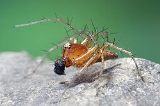
Lynx spider
Encyclopedia
Lynx Spiders are the members of the family Oxyopidae. They all are hunting spiders that spend their lives on plants, flowers and shrubs. At least one species has been identified as exhibiting social behaviour.
and they tend to differ in their habits and adaptations. For example most Oxyopes and Hamataliwa species are small to medium in size; they tend to be drab and especially the latter tend to be ambush hunters in ways resembling the crab spiders (Thomisidae). Some occupy flowers and wait for pollinating insects, whereas others lie in wait on plant stalks or bark. The Peucetia
species on the other hand, commonly are larger, vivid green, and rangy; they are active runners and leapers. Oxyopidae in general rely on keen eyesight in stalking, chasing, or ambushing prey, and also in avoiding enemies. Six of their eight eyes are arranged in a hexagon-like pattern, a characteristic that identifies them as members of the family Oxyopidae. The other two eyes are smaller and generally situated in front and below the other six.
The Oxyopidae also have spiny legs, and in many species those legs, augmented by the spines, seem to be used as a sort of catching-basket in trapping flying insects.
Common genera in the United States include Oxyopes — the common lynx spiders — and Peucetia — the green lynx spiders.
Some members of the genus Oxyopes are abundant enough to be important in agricultural systems as biological control agents.
This is especially true of the striped lynx spider (Oxyopes salticus
).
A member of the genus Tapinillus is remarkable as being one of the few social spider
s, living in colonies.
Description and habits
There are several generaGenus
In biology, a genus is a low-level taxonomic rank used in the biological classification of living and fossil organisms, which is an example of definition by genus and differentia...
and they tend to differ in their habits and adaptations. For example most Oxyopes and Hamataliwa species are small to medium in size; they tend to be drab and especially the latter tend to be ambush hunters in ways resembling the crab spiders (Thomisidae). Some occupy flowers and wait for pollinating insects, whereas others lie in wait on plant stalks or bark. The Peucetia
Peucetia
Peucetia is a genus of lynx spiders that is found worldwide.While P. viridana is found only in India and Myanmar, the similar named P. viridans occurs only from the southern USA to Venezuela....
species on the other hand, commonly are larger, vivid green, and rangy; they are active runners and leapers. Oxyopidae in general rely on keen eyesight in stalking, chasing, or ambushing prey, and also in avoiding enemies. Six of their eight eyes are arranged in a hexagon-like pattern, a characteristic that identifies them as members of the family Oxyopidae. The other two eyes are smaller and generally situated in front and below the other six.
The Oxyopidae also have spiny legs, and in many species those legs, augmented by the spines, seem to be used as a sort of catching-basket in trapping flying insects.
Common genera in the United States include Oxyopes — the common lynx spiders — and Peucetia — the green lynx spiders.
Some members of the genus Oxyopes are abundant enough to be important in agricultural systems as biological control agents.
This is especially true of the striped lynx spider (Oxyopes salticus
Oxyopes salticus
Oxyopes salticus is a species of lynx spider....
).
A member of the genus Tapinillus is remarkable as being one of the few social spider
Social spider
A social spider is a spider species whose individuals form relatively long-lasting aggregations. Whereas most spiders are solitary and even aggressive toward conspecifics, some hundreds of species in several families show a tendency to live in groups, often referred to as colonies, and continue to...
s, living in colonies.

